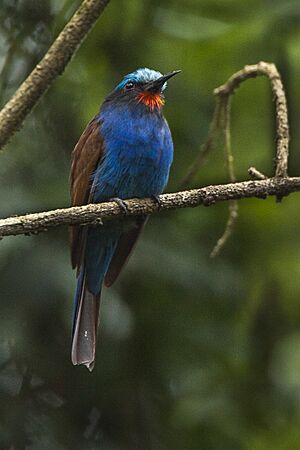Blue-headed bee-eater facts for kids
Quick facts for kids Blue-headed Bee-eater |
|
|---|---|
 |
|
| Conservation status | |
| Scientific classification | |
| Genus: |
Merops
|
| Species: |
muelleri
|
The blue-headed bee-eater (Merops muelleri) is a cool bird from the Meropidae family, also known as the bee-eater family. These birds are found in the warm, wet forests of tropical West and Central Africa. You can spot them in countries like Cameroon, Central African Republic, Republic of the Congo, Democratic Republic of the Congo, Gabon, Equatorial Guinea, and Kenya.
Contents
What Does the Blue-headed Bee-eater Look Like?
Both male and female blue-headed bee-eaters look very similar. They are about 19 cm (7.5 in) long, which is roughly the length of a ruler. Their back and wings are dark brown. The rest of their feathers are mostly a bright ultramarine blue.
Head Colors
The color of their head can be a bit different depending on where they live:
- Birds in the eastern parts of Africa have a blue crown that fades to white on their forehead.
- Birds in the western parts have heads that are completely blue.
They also have a bright scarlet (red) chin and upper throat, outlined with a black stripe. Their belly is a lighter shade of blue, and their eyes are red. Sometimes, in the dim light of the forest, people might confuse this bird with the black bee-eater (Merops gularis).
Where Does the Blue-headed Bee-eater Live and What Does It Eat?
The blue-headed bee-eater is a bird that loves the rainforest. You usually see them alone, or sometimes in pairs or small groups of three. They like to perch high up on a branch in the forest canopy. This is the top layer of trees in the forest.
From their high perch, they watch for food. When they spot a small butterfly, a honeybee, or another insect, they quickly swoop down to catch it. After catching their meal, they fly right back to their original perch.
Threats to Their Home
Sadly, the number of blue-headed bee-eaters in western Africa has gone down over the years. These birds are now facing threats across all the places they live. This is mostly because of human activities like:
- Deforestation: When forests are cut down for wood or to make space for farms.
- Cattle grazing: When too many cows eat the plants in the forest, which damages the bird's home.
What is the Blue-headed Bee-eater's Conservation Status?
The blue-headed bee-eater lives across a very large area and is still quite common. However, experts believe their population is slowly decreasing. This is due to things like their forest homes being damaged and too much grazing by cattle.
Even with this decline, the total number of these birds is still very large. The decline is also happening slowly. Because of this, the International Union for Conservation of Nature (IUCN) has decided that the blue-headed bee-eater is a species of "least concern". This means they are not currently in danger of disappearing, but it's still important to protect their forest homes.



